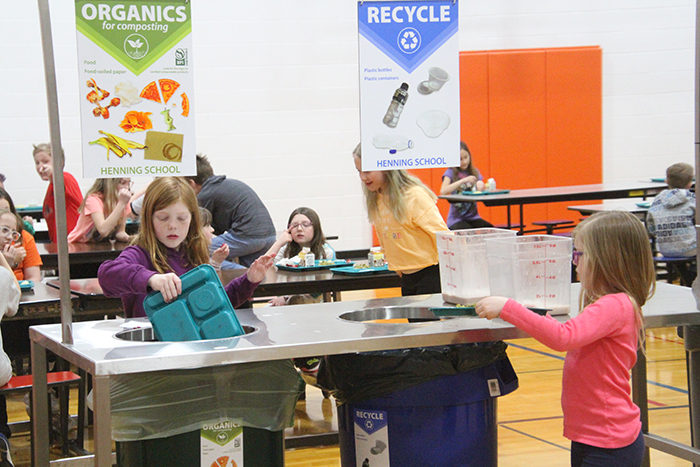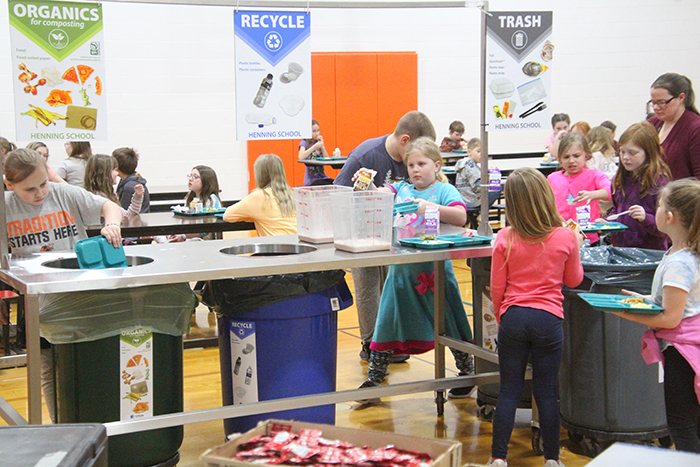New recycling program comes to Henning School
News | Published on March 16, 2022 at 2:52pm EDT | Author: Chad Koenen
0Students, staff participate in pilot program to reduce waste, increase recycling at school

A group of Henning students utilize the new table at the school during lunch on Monday. The table is part of a pilot program aimed at reducing trash in the lunch room.
By Chad Koenen
Publisher
One school’s trash could turn into another person’s black gold. Well, not necessarily the type of black gold that comes out of the ground and fills a vehicle, but the type that could help to cultivate the next corn crop or flowers to decorate a home.
As part of a pilot program recently unveiled by Otter Tail County, students at Henning School are doing their part to reduce their carbon footprint by recycling items and separating food items that could be used to make compost.
The program is part of the Organics Recycling Pilot Program, which was made possible by a Greater Minnesota Composting and Recycling grant from the Minnesota Pollution Control Agency. Organics Recycling takes food scraps and food waste and turns it into compost at a commercial facility near Hoffman, Minn.
Henning School food director Ariel Greenwood said she was approached by a representative from Otter Tail County about a new pilot program to reduce the amount of items that are placed in the landfill. The program was free for Henning School to participate in and provides students another lesson about the importance of recycling.
“I received an email from Cedar Walters earlier this year. She was looking for schools to pilot this new program. She had a grant and was looking for school.”
Ariel Greenwood, Henning School food director

Since there was no cost to participate, Greenwood agreed to have Henning be one of the pilot schools for the new program. As part of the program, students and staff members will separate the recyclable items, food waste and trash into one of three different trash bins in the lunch room. The large table and bins were provided to the school for free, as were the signs to display what items should be placed in each bin.
In addition to food waste, other items like dirty napkins and some containers can go in the organics tub. Since starting the program just over a week ago, Greenwood said the amount of waste collected at the school has went down dramatically.
“Anything food waste related, including soiled napkins can go in the organics bin. We went from changing the garbage cans four times a day to maybe one or two.”
Ariel Greenwood
Cedar Walters, Public Information and Education Officer, Otter Tail County Solid Waste, estimated that the new program will keep over 900 pounds of food waste out of the landfill each week. Other schools who are participating in the pilot program include Underwood School, Kennedy Secondary School, Cleveland Elementary, the Area Learning Center and Parkers Prairie School.
In her first year as food director, Greenwood said the amount of trash collected in the lunch room was more than she was anticipating. The new program is helping to cut down on the amount of trash collected and students have seemed to catch on to the program rather quickly. She was also glad to see the school could turn a half eaten meal into something of a greater use, instead of just more trash for the landfill.
“I thought it was a good idea and being my first year in the kitchen, I didn’t expect to see as much garbage go out as it did. Having a program where we could make something of not eating an entire sandwich (is a positive).”
Ariel Greenwood

Organic waste makes up 25-30 percent of the waste stream, which is the largest portion after traditional recycling materials. Organic matter in a landfill doesn’t decompose the way it would in nature, due to the oxygen-poor environment. If the material does decompose, it does so in a matter of decades, instead of a matter of months.
“Some of the participating sites will see a reduction in waste generation of 30 percent or more as a result of participating in this program. In one cafeteria, 50 percent of the waste was compostable, so they will be instantly cutting their waste in half by participating in organics recycling. This is something we look forward to celebrating with our participating sites,” said Walters.
During the duration of the grant project, which continues through June of 2023, the program is expected to divert approximately 200 tons (40,000 lbs.) of organic material from the waste stream for composting.

